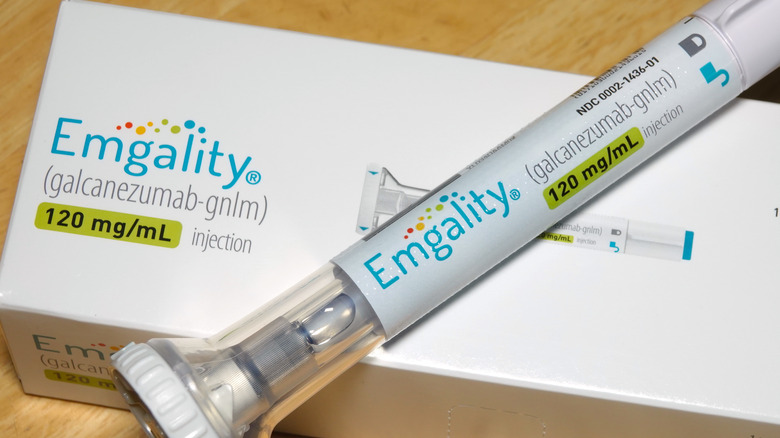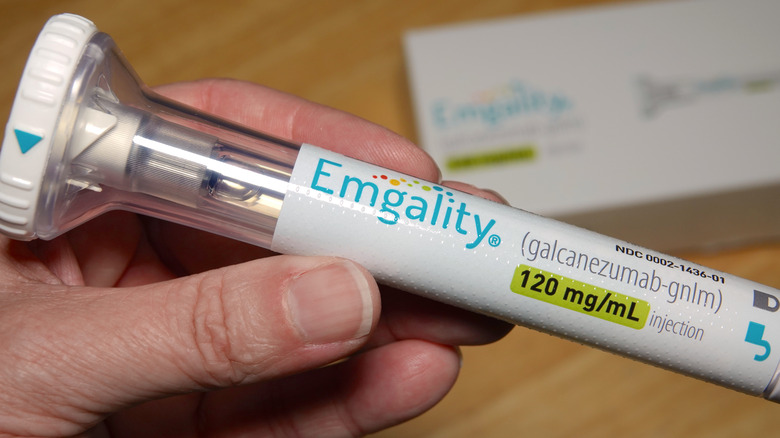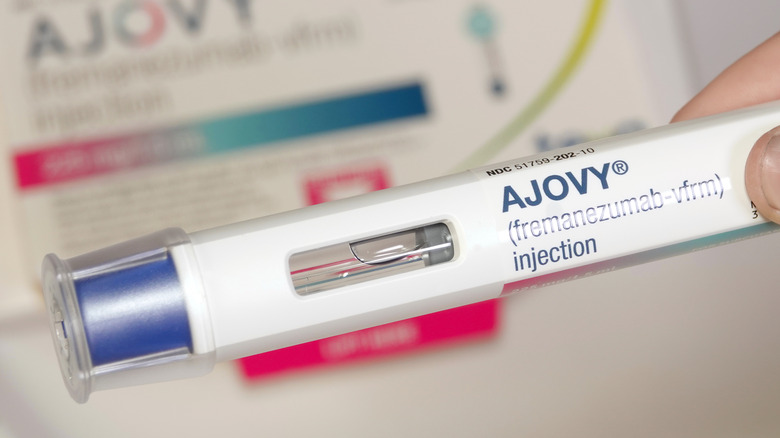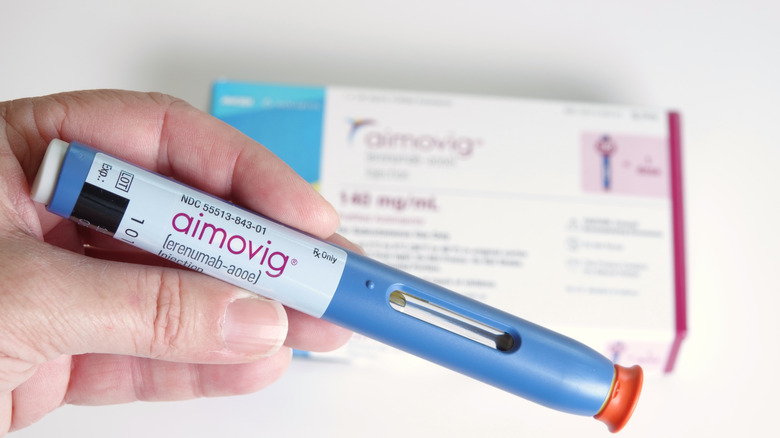Emgality Explained: Usage, Dosage, And Side Effects
Migraines are a significant health issue. If you have chronic migraines, you probably know that they can be life-altering. They can keep you from working or spending time with friends or loved ones, and they can make it hard for you to even get out of bed in the morning. According to the American Migraine Foundation (AMF), approximately 39 million Americans experience this debilitating condition. The AMF suspects that the actual statistic can be much higher, but explains that it is hard to tell due to cases of misdiagnosis. In addition, since it is not yet clear what causes them, people with migraines often feel like there's little they can do to reduce or prevent the symptoms — or worse, some patients don't tolerate or respond to available treatment options.
The good news is that there's a relatively new treatment for migraines called Emgality, a prescription medicine that helps prevent migraines and cluster headaches (another debilitating headache disorder). Emgality is the brand name for the FDA-approved medication galcanezumab-gnlm, which is injected monthly to reduce the frequency of future migraines rather than treating them once they appear. It comes in a single-dose prefilled pen that you can easily administer yourself without having to visit your doctor's office. It is also a single-use injector that you should carefully discard after using. Keep reading to learn more about how Emgality works and what makes it different from other migraine treatments.
What are migraines?
If you've ever experienced a pounding or throbbing and intense pain on one side of your head, you've most likely had a migraine attack. According to the National Institute of Neurological Disorders and Stroke, migraines are a type of headache that can last anywhere from four hours up to three days and are characterized by showing up with additional symptoms such as nausea, vomiting, and sensitivity to strong smells, light, and noise. There are two main types: with aura and without aura. They differ from one another because the aura comes with visual symptoms, numbness, or tingling that act as a warning for the upcoming pain.
The American Migraine Foundation (AMF) also explains that a migraine attack may come in four different phases for some people, yet not everyone experiences or notice all of them. The first phase (prodrome) may appear a couple of hours or even days before the attack, and its symptoms include excessive yawning, tiredness, irritability, and cravings. The second phase is the aura, followed by the headache phase. The last phase, postdrome, is described as a "migraine hangover" in which people may feel tired, dizzy, and still be disturbed by bright lights.
While there is no clear cause for migraines, the AMF states that common triggers include stress, traumatic events, disordered sleep and eating patterns, alcohol intake, and weather changes. Additionally, hormonal changes may cause migraines in women. In fact, migraines are three times more common in women than men.
What are cluster headaches?
As its name suggests, cluster headaches are a headache disorder that happens in groups or bursts of brief yet severely painful attacks known as cluster cycles, per the American Migraine Foundation (AMF). Cluster headaches are believed to be the most painful type of headache, and unlike people with migraine who prefer to lie down or stay still, those with cluster headaches are described as being restless as a means to try and find a distraction from the pain.
Another major difference between migraines and cluster headaches is that the latter commonly appears every day out of the blue, can last up to three hours, and involves a stabbing-like feeling focused around, behind, or in one eye. Other common symptoms include swelling and redness around the same eye, drooping eyelids, and stuffy nose or sweating on the affected side (via the Mayo Clinic). Cluster cycles may happen seasonally and often at the same time each day, lasting anywhere from weeks to months. However, depending on the type of cluster headache, you may also have some remission or headache-free periods.
There are two types of cluster headaches, based on how often these painless periods occur (via the AMF). Episodic cluster headaches are those that have pain-free periods between the attacks, which may last three months or longer. In contrast, chronic cluster headaches have fewer pain-free days, and the attacks can last over a year. Lastly, unlike migraines, cluster headaches affect more men than women.
How does Emgality work?
Emgality is a class of medication used to prevent migraines and cluster headaches. It is a type of monoclonal antibody that belongs to a group of drugs known as calcitonin gene-related peptide (CGRP) inhibitors, which means it is designed to bind to a specific protein in the body to keep it from attaching to its receptor and activating its release (via StatPearls).
CGRP, the protein that Emgality targets, is involved in the regulation of pain and inflammation in the brain (via Drugs.com). In fact, CGRP is known to be the protein responsible for migraine attacks, seeing that they usually appear when CGRP levels increase. Therefore, by blocking or reducing its activation, Emgality can reduce the frequency and severity of these headaches and keep the pain associated with migraines and cluster headaches at bay.
It's important to remember that Emgality is designed to prevent migraines or cluster headaches, and it's not used to treat a migraine or cluster headache attack after it has begun. According to Drugs.com, Emgality is quite effective. It starts working within the first month of use, and can take up to six months to see its full migraine-reduction effects. As for cluster headaches, you may experience Emgality's benefits within the first week, but its full effect might take up to three weeks.
How to take Emgality?
Emgality comes in a single-dose, single-use prefilled pen that allows easy self-administration (via Emgality). Each pen has an injection button, a lock ring, a clear base, and a base cap that protects the needle. The pen should be kept refrigerated, but must be left at room temperature for half an hour before use.
Before injecting the medication, wash your hands and wipe the injection site with alcohol. Then, twist off the pen's base cap, place the pen flat and firm in the injection site, unlock the lock ring, and press the injection button, which will produce a loud click. Hold the pen in place for about 10 more seconds until you hear a second click, which indicates that the injection is complete. Per the medication's instructions, you should rotate your injection site for each dose to reduce the risk of skin irritation. Ideal injection sites include your stomach (but avoid the first two inches that surround your belly button), the back of your upper arms, your buttocks, or the front of your thighs in an area between two inches below the groin and two inches above the knees.
Emgality is administered once a month in a single 120-milligram dose for migraines. However, a 240-milligram initial or loading dose is needed the first time you use it (meaning you'll need two pens). For cluster headaches, you'll need three 100-milligram injections (300 milligrams total) at the beginning of the cluster cycle and then monthly until the end of the cluster period.
Emgality interactions
According to Drugs.com, there is only one other drug known to interact with Emgality: an immune globulin called efgartigimod alfa, which goes under the brand name Vyvgart. Efgartigimod alfa is used to treat myasthenia gravis (MG), a chronic autoimmune disease that causes muscle weakness (via the National Institute of Neurological Disorders and Stroke).
The interaction between both medications is classified as moderate, which means that it has some clinical relevance. Thus, taking both treatments at the same time should be avoided or used only in very specific or particular cases as directed by a healthcare provider. When taken together, efgartigimod alfa may reduce the amount of Emgality present in your blood, which leads to an overall reduction in the drug's efficacy — meaning that it may not be as effective in preventing migraines or cluster headaches.
mgality does not interact with foods or alcohol, as well as vitamins or herbal medicines. However, be sure to talk to your doctor beforehand to be sure Emgality is the right treatment for you.
Potential side effects of taking Emgality
Emgality is known for having few severe side effects (although it doesn't mean there aren't any). The most common side effect reported in clinical trials was injection site reactions, including site pain, redness, inflammation, and itching (via StatPearls). These side effects are usually mild and go away on their own within a few days. Additionally, other common side effects include vertigo or dizziness and constipation, and in some cases, people may develop anti-drug antibodies, which would reduce the drug's efficacy (via Drugs.com).
Nevertheless, in rare cases, more serious side effects may occur. These include allergic reactions, such as difficulty breathing, hives, rash, itching, and swelling of the face, lips, tongue, or throat. These are considered serious effects and require immediate medical attention. Note that an allergic reaction to Emgality may occur days after administering your dose (via Emgality). Regardless of which side effect you experience, you should talk with your healthcare provider if you experience any unusual or severe symptoms while taking Emgality.
Emgality, pregnancy, and breastfeeding
According to Drugs.com, the safety of Emgality during human pregnancy has not been established, yet animal studies show no adverse effects on fetal development (although keep in mind that animal studies do not always predict the effects of a drug in humans). Nevertheless, the benefits of taking Emgality should outweigh the potential risks. Still, if you are pregnant or planning to become pregnant, it is important to discuss it with your healthcare provider before taking Emgality. They will be able to help you make an informed decision about whether to continue taking the drug or to switch to a different treatment.
As for taking Emgality while breastfeeding, a review published in the Drugs and Lactation Database states that while there isn't any information available on the drug's potential adverse effects, the large size of the molecule galcanezumab (the active component in Emgality) makes it unlikely for it to be passed on from the mother to the baby through breast milk and that if it does, it will most likely be destroyed by the baby's gastrointestinal tract.
Keep in mind that without enough available information, Emgality should be taken with caution, especially if you have a newborn baby, or if your baby was born ahead of time. Still, be sure to also discuss this with your healthcare provider, who can help you decide whether taking the drug is a viable choice or to stop breastfeeding.
Emgality cost
Emgality is a prescription medication, and whether it is covered by insurance will depend on the specific insurance policy. Some insurance plans may cover Emgality, while others may not. According to Lilly, Emgality's manufacturer, the list price (or the price at which Emgality is sold to wholesalers) is $679.20 for one 120-milligram prefilled pen. However, that is most likely not the price you'd pay as a patient (unless you don't have insurance coverage for prescription medication, or if your insurance doesn't cover this treatment).
The cost of Emgality can vary depending on the specific insurance plan, the dosage, and the frequency of treatment. The majority of Emgality prescriptions cost between $0 and $25 per month if you have an individual private policy or insurance by an employer. The price may be as low as $4 or as high as $150 per month, depending on your insurance plan and coverage.
It's important to check with your insurance provider to find out if Emgality is covered under your specific plan and what the cost will be. You can also ask your healthcare provider for more information about financial assistance options available. For instance, there is an Emgality Savings Card available for commercially insured patients, which can help you get your treatment for free for up to one year (via Emgality).
Ajovy versus Emgality
Ajovy (fremanezumab) and Emgality (galcanezumab) are two medications used to prevent migraines in adults. Both medications are monoclonal antibodies that target calcitonin gene-related peptide (CGRP), meaning that they are both CGRP inhibitors (via Drugs.com). However, there are a couple of differences between the two.
Per Drugs.com, one of the main differences between Ajovy and Emgality is their dosing and schedule. While both are subcutaneous injections, Ajovy requires a higher dosage of 675 milligrams, compared to just 120 milligrams of Emgality. In addition, it is injected every three months, and you need to take three consecutive injections each time to reach the necessary dose. In contrast, Emgality is given on a monthly basis, and you only take two injections the first time. Another important difference is that Emgality is also prescribed for the treatment of cluster headaches, while Ajovy only works for migraines.
Nevertheless, the efficacy of both drugs is similar, as well as their potential side effects, and neither of them has any known food or alcohol interactions. Thus, the choice between Ajovy and Emgality will depend on your individual needs, such as the frequency of migraines and your preference for dosing schedule.
Aimovig versus Emgality
Like Emgality, Aimovig (erenumab) is another injected medication prescribed to prevent migraines that acts as a calcitonin gene-related peptide (CGRP) inhibitor. Unlike Emgality, however, this one is not approved for the treatment of cluster headaches (via Drugs.com).
While both drugs come in single-use and prefilled injection pens or syringes that are administered once a month, they differ in dosage. Emgality has a recommended monthly dose of 120 milligrams. In contrast, at 70 milligrams per month, Aimovig's dosage is much lower — except for the less common cases in which a 140-milligram dose is needed (achieved by using two pens at a time). In addition, scientific studies have linked Aimovig to greater migraine-free days compared to Emgality (per Drugs.com).
Furthermore, Aimovig has a lower rate of side effects associated with injection site reactions, such as redness and swelling, compared to Emgality. However, it also has additional side effects (e.g., muscle spasms, cramps, and tiredness) which have not been associated with Emgality use. As with any other prescription medication, it is important to consult with your healthcare provider to discuss the best options available for you.
Ubrelvy versus Emgality
Emgality and Ubrelvy (ubrogepant) are two medications used to treat migraines in adults, but they work in different ways. While they both belong to a class of drugs called calcitonin gene-related peptide (CGRP) inhibitors, Emgality is a type of inhibitor known as a monoclonal antibody, and Ubrelvy is a CGRP receptor antagonist or gepant. According to Drugs.com, this means that Emgality can help prevent migraines, while Ubrelvy is used to treat acute migraines (you only take it once the migraine attack has started).
Another difference between the two is their reaction type. Since Emgality's active component has a larger size, it takes longer for its effects to appear. In contrast, Ubrelvy's smaller molecule size means it can act quicker, which is why it works best as a treatment rather than a preventative drug.
For the same reason, both drugs' recommended dosages also differ. While Emgality is given as an injection once a month, Ubrelvy is a tablet taken orally, usually once or twice a day when needed. Additionally, Emgality's long-lasting effect has you covered for an entire month, while Ubrelvy has a much shorter effect, lasting only about a day (via Drugs.com). Lastly, unlike Emgality, Ubrelvy can interact with numerous drugs and herbal products, such as antibiotics, antifungals, turmeric, and St. John's wort.
Alternatives to Emgality
Aside from Ajovy and Aimovig, which are injected preventative medications just like Emgality, there are over 50 different therapy options you can consider for your migraine (per Drugs.com), even if they weren't initially developed for the treatment of migraines. One such type of treatment is Botox (onabotulinumtoxin A), a type of injectable medication that is used to treat migraines by relaxing the muscles and nerves that contribute to headache pain, according to Drugs.com. Moreover, oral medications like Ubrelvy and Nurtec ODT (rimegepant) help treat migraine attacks after the pain begins, offering immediate effects.
However, if you're looking for a different approach, the American Migraine Foundation (AMF) shares additional drug-free alternatives, including magnesium supplements, acupuncture or acupressure, green light therapy, and aerobic exercise. Low levels of magnesium may be linked to migraines, and taking magnesium supplements may help reduce the frequency of migraines. As for acupuncture and acupressure, these traditional Chinese medicine treatments may help reduce pain and stress, thus preventing migraine attacks or reducing their severity. Regarding green light therapy, this type of light therapy uses a specific wavelength of green light to reduce the intensity of migraines. Lastly, regular aerobic exercises such as walking, jogging, or cycling have been found to be effective in reducing the frequency and severity of migraines.













